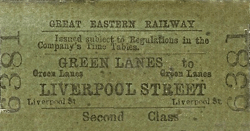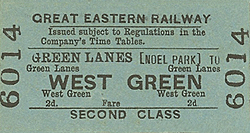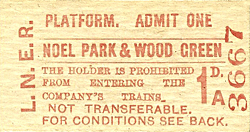Notes: Green Lanes was the temporary terminus of the branch opening on 1st January 1878. It became a through station on 7th October 1878 when the extension to Palace Gates was opened. The station comprised two wooden platforms, situated on embankment. Track level buildings were also wooden, but the booking office, which stood to the east of Wood Green High Road, was built of brick. The goods yard was at street level with a signal box controlling access to the yard sited at the north end of the station. The yard was on the 'up' side of the line between Lymington Avenue and Westbury Avenue (see map below)
 |
At the time of construction, both West Green and Green Lanes stations served villages which were still separated from London by countryside, but the districts quickly became more urbanised. Between 1881 and 1883, the Artizans’, Labourers & General Dwellings Company erected the Noel Park housing estate nearby, and from 1st May 1884, Green Lanes |
station was renamed Green Lanes & Noel Park. A further change of name came on 1st January 1902, when all reference to its original title was lost, and it became Noel Park & Wood Green.
By the mid-1930s, Noel Park station was in a dilapidated condition and the LNER Board agreed that it should be rebuilt. At a meeting in May 1937, it was suggested that all the necessary improvements could be made at a cost of around £4,950, although there was doubt as to whether the premises merited the investment. However, with 250,000 passengers using it the previous year, modifications were deemed worthwhile, and a rebuilding scheme went ahead. The job entailed construction of new platforms, with replacement waiting shelters on either side. Both buildings were again constructed of wood and incorporated entrances to the stairways which led into the booking hall. The street level building received a few cosmetic changes, including a rendered frontage, but work ceased at the outbreak of war in September 1939, and no further alterations were undertaken.
The Palace Gates branch suffered little damage during the war but on 16th January 1941, the embankment on the down side at Noel Park was hit, but the station remained almost unscathed.
| In connection with Charter Jubilee celebrations held by the local borough council, an exhibition of locomotives and rolling stock was staged in Noel Park goods yard between 12th and 14th September 1958. Steam engines on display comprised record breaking ‘A4’ 4-6-2, 60022 ‘Mallard’, ex-GNR ‘C12’ 4-4-2T, 67352, ex-GNR ‘J52’ 0-6-OST, 68846, and BR |
 |
Standard 9F 2-10-0, 92196. There were also three diesels, English Electric Type 4 Co-Co, D208, Sulzer Type 2 Bo-Bo, D5300, and 0-6-0 shunter No.D3490. Special 'edmondson' tickets were produced for the event and all proceeds went to charity. The exhibition was very successful, and during its three days, was visited by around 14,000 people.
After closure to passengers in 1963 the station remained open to goods traffic until 5th October 1964. Both trackside buildings were damaged by fire in c.1966 before the track was lifted and they were demolished in c.1968. The platforms lasted a little longer but were subsequently demolished along with the embankment and the whole site is now occupied by the Wood Green Shopping City. The two-storey building still standing in what is now Gladstone Mews adjacent to the site of the former station entrance has often been mistaken for a railway building but was, in fact, a slaughterhouse supplying meat to the local butcher. The goods yard is now lost under The Sandlings housing estate..
 |
BRIEF HISTORY OF THE PALACE GATES BRANCH
In 1866 the Great Eastern Railway received parliamentary approval for branch line to serve the new leisure complex of Alexandra Palace which was under construction. The line was to run from a junction with the existing Enfield line at Seven Sisters to an end on junction with the Great Northern line from Finsbury |
Park to Highgate which received parliamentary approval in 1864. No work was undertaken and the line was abandoned in 1869 due to cost and the steep gradient up to the Palace site. The west end of the line between Highgate and Muswell Hill was built by the GNR, opening in 1873 with an extension to Alexandra Palace opened by the Muswell Hill & Palace Railway on the same day.
The Palace, which also opened on the same day as the railway was an immediate success but this was short lived as it was gutted by fire 17 days later, reopening in May 1875. In an attempt to capitalise on the popularity of the Palace as a tourist attraction the Great Eastern resurrected their line from Seven Sisters but this time it was a more modest scheme, terminating at a station called Palace Gates adjacent to the GNR's Wood Green station and avoiding the steep climb up to the Palace. Passengers wanting to reach the Palace faced a steep 3/4 mile walk from the new terminus.
| Parliamentary approval was received in 1874 and construction of the 2 1/2 mile double track branch started almost immediately with intermediate stations at West Green and Green Lanes. The line opened between Seven Sisters and Green Lanes on 1st January 1878 with the final section to Palace Gates opening on 7th October 1878. |
 |
Initially services ran from Liverpool Street but from January 1880 trains also ran to Stratford and Fenchurch Street using a new junction at South Tottenham. From 1st September 1880 this service was diverted to Blackwall via the 'Limehouse Curve' but this service was not well used and was withdrawn a few months later. From 1st June 1887 a new service to North Woolwich was introduced which was to remain through the line's life.
 |
Alexandra Palace never lived up to expectations as a tourist attraction. Tourist traffic on the branch never amounted to much except on special occasions such as bank holidays and exhibitions. The line relied on commuter traffic to the City and the East London docks. The Palace Gates branch was at its height in the early 20th century with a 30-minute interval off-peak service to Liverpool Street (more during peak hours) with 41 up and 38 down trains between Palace Gates and Liverpool Street and an hourly weekday service to North Woolwich (less frequent on Sundays). Passenger numbers were soon in decline however due to a change in employment patterns (local road journeys to new factories instead of radial rail journeys) and improved road transport as tramways spread northwards, reaching Wood Green from Finsbury Park in 1904. Local bus services were also improved and it was soon quicker to reach central London by road.
 |
In 1912 the Sunday service into Liverpool Street was withdrawn and replaced by a shuttle between Seven Sisters and Palace Gates. Although fewer people now used the line to reach central London it still provided a useful commuter service to the East London Docks and during WW1 it was used by munitions workers commuting to the Woolwich Arsenal. |
From 12th July 1920, the Great Eastern introduced a new intensive suburban timetable which revolutionised workings in and out of Liverpool Street. To aid easy identification of trains by passengers, and therefore avoid congestion around the barriers, all rolling stock became colour coded. First and second class compartments were denoted by yellow and blue bands respectively, and a coloured board was also attached to the sides of the guard’s van to identify the train’s ultimate destination. In the case of through workings to Palace Gates this was pink. The garish collection of hues soon brought the nickname ‘The Jazz Service’. The new timetable also brought new rolling stock with the introduction of 2-car 'auto' or push-pull sets which provided the half hourly slack period working and at peak hours connected with Enfield line trains at Seven Sisters, alternating with through trains between Palace Gates and Liverpool Street making a combined 10-minute frequency.
| Although the track north of Palace Gates station terminated very close to the Great Northern line there was no physical connection until 1929. Even then there was only a single line used almost entirely for stock movements from the Great Eastern Section to the carriage washing plant at Bounds Green, although it also saw a few excursion workings towards the end of |
 |
the 1930s. After the first war passenger numbers continued to decline not helped by the opening of the Piccadilly Line from Finsbury Park to Arnos Grove on 19th September 1932. New tube stations at Turnpike Lane, Wood Green and Bounds Green all took passengers from the Palace Gates branch.
While passenger numbers to and from London fell the North Woolwich service was still relatively well patronised with 14 weekday train and an hourly Sunday service still running in 1938. Following the outbreak of war in 1939 an emergency timetable was introduced with only one morning train running between Liverpool Street supplementing the shuttles and the North Woolwich service.
 |
The connection with the Great Northern had strategic wartime uses, and it was therefore re-laid to allow easier through running soon proving a valuable link for essential wartime freight traffic. From 6th July 1942 the shuttle service was withdrawn and never reinstated. Following the end of the war and the sole surviving Liverpool Street to Palace Gates to Palace Gates train |
was withdrawn in 1947
After the war passenger numbers on the remaining North Woolwich service declined rapidly and this was soon reduced to a peak-hour-only Monday - Friday service with a very limited weekend service of one morning and one afternoon train. There was however little demand for this weekend service and it was soon withdrawn. The shuttle service was surprisingly reinstated in May 1948 but discontinued again in January 1951 due to shortages of fuel.
The peak hour North Woolwich service continued through the 1950's with the occasional excursion to Southend or Clacton using the branch. In May 1959 the 1944 connection was to prove useful once more when engineering work at Broxbourne meant that Cambridge trains were diverted along the branch. The locomotive depot at Palace Gates closed in June 1954 although by this date it was run-down and the turntable had been out of use for some time.
| The branch was the last part of the former Great Eastern suburban system to be worked entirely by steam although in the early 1960's some diesel loco’s were used and from 1st January 1962 some workings were taken over by DMUs. By this time there were six daily trains from Palace Gates to North Woolwich, and nine in the opposite direction, all at peak times only. It |
 |
came as no surprise when closure was eventually announced for 5th January 1963 with the last train consisting of four coaches packed with mainly enthusiasts hauled by Brush Type 2 Alma-Ata diesel loco. The train returned to Stratford empty.
Freight services carried on for a littler longer with the goods yards at Noel Park and Palace Gates closing on 5th October 1964 while that at West Green closed on 7th December 1964. Through freight traffic ceased on 28th December 1964. Since July 1958, there had been a coal concentration depot in the sidings at Palace Gates and this remained in use, although it was reached by way of the connection with the former GNR at Bounds Green. The track was lifted in 1966 and today although some sections of the track bed have been developed the track is for much of its course traceable and a number of overbridges remain extant. All the station sites have been redeveloped with the exception of the north end of Palace Gates and Seven Sisters which is now a public park.
Other web sites: Abandoned
Tube Stations Tickets from Michael Stewart except 0178 & 3970 from Brian Halford
Sources:
To see other stations on the Palace Gates branch click on the station name:
Seven Sisters, West Green & Palace Gates (Wood Green) |

green_old7.jpg)


green_old1.jpg)
green_old3.jpg)
green23.jpg)

green29.jpg)

green6.jpg)
green20.jpg)











 Home Page
Home Page